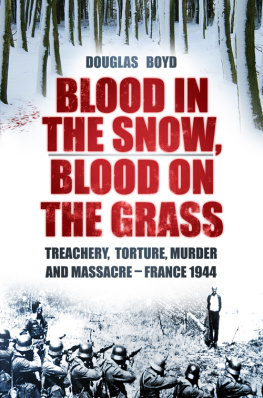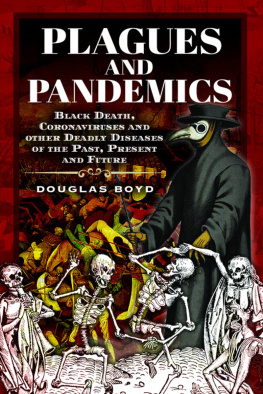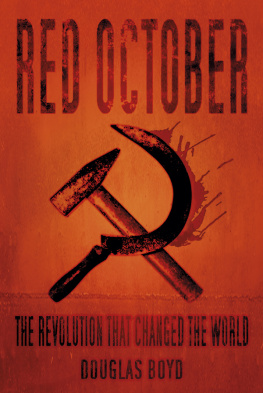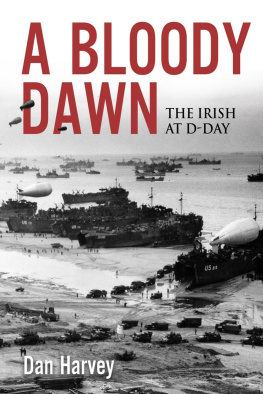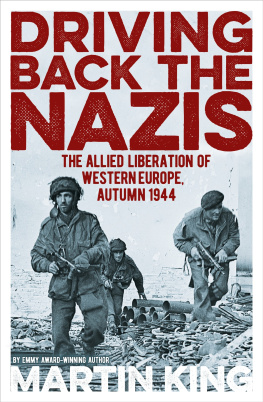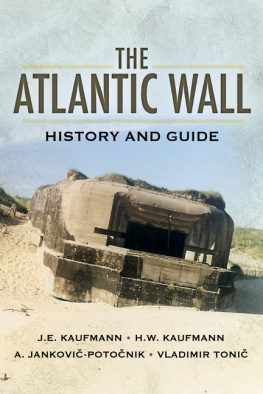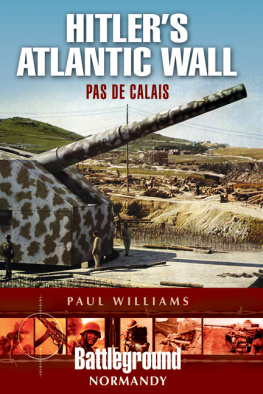NORMANDYS
NIGHTMARE
WAR
Famous for Calvados apple brandy and Camembert cheese, Normandy is a green and pleasant land now dotted with thousands of British-owned second homes. Its coastline is also dotted with thousands of indestructible reinforced-concrete bunkers and gun emplacements that formed part of the Atlantic Wall of Hitlers Fortress Europe.
Tourists passing through the ferry ports like Boulogne, Cherbourg and Dunkirk and inland cities like Rouen and Caen may wonder why there are so few old buildings, but few know that the demolition which preceded the extensive urban renewal of the ancient town centres was effected by British bombs during four years of hell for the people living there. Before its belated liberation three long months after D-Day, the sirens in Le Havre wailed 1,060 times to warn of approaching British and American bombers. After one single raid, over 3,000 dead civilians were recovered from the citys ruins, without counting the thousands of injured, maimed and traumatised survivors.
So, whom did the Normans regard as the enemy: the German occupiers who shot a few hundred rsistants or the Allied airmen who killed as many in northern France as died in Britain from German bombs during the whole war?
Here, told largely in the words of French, German and Allied eyewitnesses, including the moving last letters of executed hostages, is the story of Normandys nightmare war.
NORMANDYS
NIGHTMARE
WAR
THE FRENCH EXPERIENCE OF NAZI OCCUPATION AND ALLIED BOMBING 1940-45
DOUGLAS BOYD
First published in Great Britain in 2019 by
Pen and Sword History
An imprint of
Pen & Sword Books Ltd
Yorkshire - Philadelphia
Copyright Douglas Boyd, 2019
ISBN 978 1 52674 581 1
eISBN 978 1 52674 582 8
Mobi ISBN 978 1 52674 583 5
The right of Douglas Boyd to be identified as Author of this work has been asserted by him in accordance with the Copyright, Designs and Patents Act 1988.
A CIP catalogue record for this book is available from the British Library.
All rights reserved. No part of this book may be reproduced or transmitted in any form or by any means, electronic or mechanical including photocopying, recording or by any information storage and retrieval system, without permission from the Publisher in writing.
Pen & Sword Books Ltd incorporates the Imprints of Pen & Sword Books Archaeology, Atlas, Aviation, Battleground, Discovery, Family History, History, Maritime, Military, Naval, Politics, Railways, Select, Transport, True Crime, Fiction, Frontline Books, Leo Cooper, Praetorian Press, Seaforth Publishing, Wharncliffe and White Owl.
For a complete list of Pen & Sword titles please contact
PEN & SWORD BOOKS LIMITED
47 Church Street, Barnsley, South Yorkshire, S70 2AS, England
E-mail:
Website: www.pen-and-sword.co.uk
or
PEN AND SWORD BOOKS
1950 Lawrence Rd, Havertown, PA 19083, USA
E-mail:
Website: www.penandswordbooks.com
Chapter 1 Days of desperation
Chapter 11 Spies, spy-hunters and bishops
Chapter 15 The silent city
About the author
Douglas Boyd has lived in France for forty years. A former BBC TV producer/director, he began collecting first-hand accounts of the French experience of war in 1968 while working on television programmes commemorating the fiftieth anniversary of the 1918 Armistice. This book is a fruit of that long research.
This is a revised and updated edition of Normandy in the Time of Darkness , first published in 2010.
Also by Douglas Boyd:
Histories:
April Queen, Eleanor of Aquitaine Voices from the Dark Years
The French Foreign Legion
The Kremlin Conspiracy: 1,000 years of Russian expansionism
Normandy in the time of Darkness: life and death in the Channel ports 194045 Blood in the Snow, Blood on the Grass: treachery and massacre, France 1944 De Gaulle: the man who defied six US presidents
Lionheart: the true story of Englands crusader king
The Other First World War: the blood-soaked Russian fronts 191422 Daughters of the KGB: Moscows Cold War spies, sleepers and assassins Agente Female spies in World Wars, Cold Wars and Civil Wars
The Solitary Spy
Red October the revolution that changed the world
Lockerbie the truth
Novels:
The Eagle and the Snake
The Honour and the Glory
The Truth and the Lies
The Virgin and the Fool
The Fiddler and the Ferret
The Spirit and the Flesh
Churchill to Eisenhower, 3 April 1944: The Cabinet took an adverse view of the proposal to bomb so many French railway centres, in view of the fact that scores of thousands of French civilians, men, women and children, would lose their lives or be injured.
Eisenhower to Churchill, 5 April 1944: I and my military advisers have become convinced that the bombing of these centres will increase our chances for success. I personally believe that estimates of probable casualties have been grossly exaggerated.
Since Eisenhower was the Supreme Commander of all Allied forces, Churchill turned to President Roosevelt the only person who could possibly influence him to change the bombing policy.
Churchill to Roosevelt, 7 May 1944: The War Cabinet have (sic) been much concerned about the number of Frenchmen killed in the raids on the railway centres in France. When this project was first put forward, a loss of 80,000 French civilian casualties, including injured, say 20,000 killed, was mentioned. The War Cabinet could not view this figure without grave dismay on account of the apparently ruthless use of the Air Forces, particularly the Royal Air Force, on whom the brunt of this work necessarily falls. It must be remembered that this slaughter is among a friendly people who have committed no crime against us.
Roosevelt to Churchill, 11 May 1944: However regrettable the attendant loss of civilian lives is, I am not prepared to impose from this distance any restriction on military action by the responsible commanders.
Note: The Institut National de la Statistique puts the body count of French civilian casualties killed by Allied air raids 194044 conservatively at 60,000, plus another 71,000 injured severely, and uncounted with minor injuries. Other estimates are higher.
List of acronyms
BEF British Expeditionary Force
CDL Comit Dpartemental de Libration committee set up in each dpartement to co-ordinate the various Resistance networks activities and to lay a political foundation for assumption of administrative powers after the Liberation



